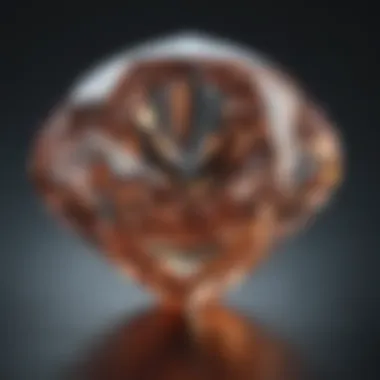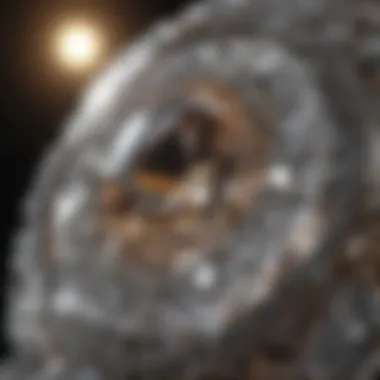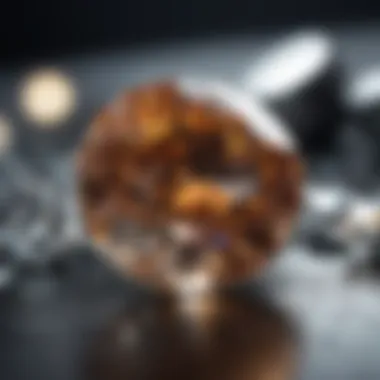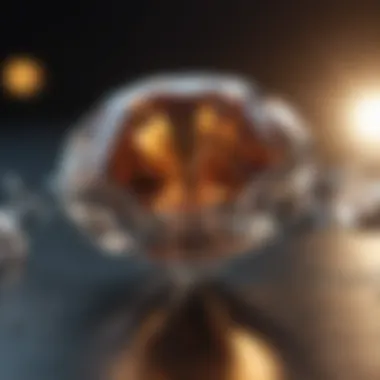Unlocking the Secrets of Authentic Diamonds: A Comprehensive Guide


Overview of Gemstones and Minerals
Gemstones and minerals have a captivating history deeply intertwined with human civilization, reflecting their cultural and societal significance. From ancient times to modern society, these precious stones and minerals have played integral roles in various aspects of human life, from adornment to healing practices.
Gemstone Formation and Properties
The formation process of gemstones is a intricate journey, typically taking millions of years deep within the Earth's crust. Various geological processes such as heat, pressure, and chemical reactions contribute to the creation of these precious stones. Gemstones are defined by specific properties such as color, hardness, and luster, which differentiate them from ordinary minerals and rocks.
Types of Gemstones
Gemstones are classified into precious and semi-precious categories, with each carrying its own unique allure and value. Common gemstone varieties encompass a wide range of stones including diamonds, emeralds, rubies, sapphires, and more. Additionally, exotic and rare gemstones offer enthusiasts the opportunity to appreciate the beauty of exceptionally unique and scarce stones.
Identifying and Evaluating Gemstones
Various factors influence the value of gemstones, including rarity, size, color, and clarity. Techniques for identifying gemstones have evolved significantly, incorporating advanced technologies like spectroscopy and microscopy. Evaluating gemstone quality involves assessing factors like cut, carat weight, and presence of any flaws or inclusions.
Caring for Gemstones
Ensuring the longevity of gemstones requires proper care and maintenance. Cleaning and storing gemstones correctly helps preserve their brilliance and beauty over time. Common mistakes in gemstone care, such as exposure to harsh chemicals or extreme temperatures, can damage these valuable stones. Each type of gemstone may have specific care requirements, necessitating tailored preservation tips for optimal maintenance.
Introduction
An epitome of magnificence, diamonds have captivated humankind for centuries with their unparalleled beauty and rarity. The value and allure of diamonds lie not only in their dazzling sparkle but also in their authenticity. The process of determining diamond authenticity is a crucial endeavor for gemstone enthusiasts, collectors, and jewelry designers alike. It unveils the true nature of these precious gems, distinguishing between genuine treasures and mere imitations. Through a meticulous examination of various physical attributes and intricate testing methods, one can unravel the authenticity of diamonds, ensuring their investment and admiration maintain their integrity.
Delving into the world of diamonds, one must navigate through a labyrinth of characteristics and treatments to unearth the genuine from the counterfeit. Understanding the physical properties of diamonds is imperative in this pursuit. Factors like hardness, refractive index, fire, brilliance, color, and clarity serve as the foundation for differentiating between real diamonds and synthetic substitutes. By scrutinizing these traits with precision and expertise, one can unravel the true essence of a diamond's authenticity.


Moreover, delving into the realm of common diamond treatments sheds light on the possible alterations that may affect a diamond's authenticity. Treatments like heat treatment, irradiation, and fracture filling are common practices in the gem industry, altering the natural state of diamonds for various purposes. Recognizing these treatments and their implications is paramount in the quest for diamond authenticity, allowing individuals to make informed decisions and identify potential red flags that may compromise the integrity of a precious stone.
In the following sections, we will explore the essential tools used for verifying diamond authenticity, ranging from diamond testers to magnification devices. These instruments act as gateways to the intricate world of diamonds, offering valuable insights through scientific analysis and observation. By harnessing the power of advanced testing methods such as spectroscopy analysis and diamond grading reports, one can elevate their understanding of diamond authenticity to unprecedented levels. Join us on this enlightening journey as we unravel the mysteries of diamond authenticity, equipping you with the knowledge and tools necessary to navigate the dazzling realm of gemstones with confidence and discernment.
Understanding Genuine Diamonds
Understanding the authenticity of diamonds is a pivotal aspect in the world of gemstones. Genuine diamonds possess distinct physical characteristics that set them apart from imitations or treated stones. These characteristics play a fundamental role in determining the quality and value of a diamond. By understanding these traits, individuals can make informed decisions when purchasing diamonds for jewelry or investment purposes.
Physical Characteristics of Diamonds
Hardness and Refractive Index
When assessing diamond authenticity, hardness and refractive index are key factors to consider. Diamonds are renowned for being the hardest natural substance on earth, scoring a perfect 10 on the Mohs scale. This exceptional hardness contributes to the diamond's durability and longevity, making it an ideal choice for jewelry that withstands daily wear. In terms of refractive index, diamonds exhibit a high index of 2.42, leading to unparalleled brilliance and fire that enhance their visual appeal.
Fire and Brilliance
Fire and brilliance are hallmark characteristics of diamonds that captivate the beholder. Fire refers to the dispersion of light into the colors of the spectrum, creating a mesmerizing play of hues within the stone. Brilliance, on the other hand, pertains to the amount of light reflected from the diamond's facets, resulting in its sparkling aura. The combination of fire and brilliance elevates the overall beauty and desirability of a diamond.
Color and Clarity
The color and clarity of a diamond are crucial determinants of its value and authenticity. Colorless diamonds are highly prized for their purity and transparency, allowing light to pass through effortlessly. Additionally, diamonds with exceptional clarity, devoid of internal imperfections or inclusions, are more valuable due to their flawless appearance. Evaluating the color and clarity of a diamond enables gemstone enthusiasts to distinguish between various grades and make well-informed choices when acquiring these precious gems.
Common Diamond Treatments
Heat Treatment
Heat treatment is a common practice in the diamond industry to enhance a stone's color or clarity. By subjecting diamonds to high temperatures, certain impurities or colorations can be altered, improving the overall aesthetic appeal of the gem. While heat treatment can result in stunning transformations, it is essential for consumers to be aware of such procedures and their potential effects on a diamond's long-term integrity.


Irradiation
Irradiation involves exposing diamonds to radiation to alter their color appearance. This treatment is utilized to produce fancy-colored diamonds, such as blues, greens, or yellows, which may not occur naturally. While irradiation can create striking hues, buyers should exercise caution when purchasing irradiated diamonds to ensure full disclosure and transparency regarding the treatment's impact on the stone.
Fracture Filling
Fracture filling is a technique used to enhance the clarity of diamonds by filling surface-reaching fractures with a glass-like substance. This method improves the visual appeal of diamonds by reducing the visibility of flaws, increasing their perceived quality. However, it is essential for individuals to be informed about fracture-filled diamonds and consider the implications of such treatments on the stone's authenticity and long-term maintenance.
Tools for Authenticity Verification
In the realm of diamond examination, the tools for authenticity verification emerge as a critical facet in upholding the purity and value of these precious gemstones. These tools serve as the gatekeepers to ensuring that genuine diamonds are distinguished from their synthetic or treated counterparts, a pivotal need in the gemstone industry. By employing specialized instruments tailored for diamond assessment, gemstone enthusiasts and professionals can confidently navigate the intricate landscape of diamond authentication. Each tool brings forth unique capabilities and functionalities designed to unravel the mystique surrounding these coveted gems.
Diamond Tester
Thermal Conductivity Probe
The Thermal Conductivity Probe stands as a stalwart ally in the quest for diamond authenticity, relying on the fundamental principle that diamonds conduct heat differently than their imitative counterparts. This probe delves into the thermal conductivity properties of diamonds, allowing experts to discern the characteristic heat conduction patterns exhibited exclusively by genuine diamonds. It serves as a cornerstone tool in diamond verification processes, offering a reliable and efficient method to distinguish authenticity with precision. The Thermal Conductivity Probe's unparalleled capacity to detect subtle variations in heat conductivity enables gemstone enthusiasts to affirm the legitimacy of their prized diamonds with undeniable clarity.
Electric Conductivity Probe
Distinct from its thermal counterpart, the Electric Conductivity Probe operates on a different principle, exploiting the electrical properties of diamonds to ascertain their authenticity. By analyzing the response of diamonds to electrical currents, this probe unveils unique electrical conductive traits inherent to genuine diamonds. Renowned for its precision and accuracy, the Electric Conductivity Probe unveils a nuanced perspective on diamond authenticity, amplifying the assurance and certainty in the verification process. While each probe offers distinctive insights into the identity of diamonds, the Electric Conductivity Probe's prowess in electrical conductivity evaluation cements its significance in the realm of diamond verification.
Magnification Devices
In the exploration of diamond authenticity, magnification devices play a pivotal role in elucidating the intricate details and characteristics embedded within these stunning gemstones. Leveraging the power of magnification, gemstone aficionados can unravel the mesmerizing world concealed within diamonds, unveiling nuances that elude the unaided eye. Magnification devices such as loupes and microscopes serve as windows into the microscopic realm of diamonds, unveiling imperfections, inclusions, and unique features that authenticate the gem's natural origins.


Loupe
The Loupe, a quintessential tool in every gemologist's arsenal, offers a close-up examination of diamond facets, ensuring a meticulous inspection of its clarity and quality. With its precision optics and high magnification capabilities, the Loupe unveils the mesmerizing details within diamonds, showcasing their brilliance and authenticity with unparalleled clarity. By enabling gemstone enthusiasts to explore diamonds at a microscopic level, the Loupe elevates the verification process, empowering individuals to make informed judgments regarding the genuineness of their prized gems.
Microscope
Stepping into the domain of advanced magnification, the Microscope transcends the boundaries of visual inspection, offering a deeper dive into the structural elements of diamonds. Equipped with enhanced magnification capabilities and intricate lighting mechanisms, the Microscope unveils the intricate world within diamonds, highlighting unique characteristics and identifying imperfections that hallmark the gem's natural formation. With its ability to unveil microscopic details with exceptional clarity, the Microscope emerges as an indispensable tool for gemstone professionals, providing a comprehensive view of diamond authenticity that transcends surface appearances.
UV Light Source
Among the arsenal of tools for diamond verification, the UV Light Source emerges as a covert ally in the battle against diamond imitations and enhancements. By harnessing the power of ultraviolet light, this tool unveils hidden fluorescent properties inherent to diamonds, shedding light on vital clues that determine authenticity. The UV Light Source serves as a beacon of truth in the authentication process, illuminating nuances that evade the naked eye and exposing subtle differentiators that authenticate genuine diamonds. With its ability to reveal the unique fluorescence patterns of diamonds under ultraviolet light, this tool stands as a stalwart companion in the pursuit of diamond authenticity, uncovering concealed truths and fortifying the verification process.
Advanced Testing Methods
In this section, we delve into the crucial aspect of Advanced Testing Methods in the realm of diamond authenticity verification. Understanding the importance of utilizing these methods is paramount in ensuring the genuineness of precious gemstones. By employing Advanced Testing Methods, gemstone enthusiasts, collectors, and jewelry designers can delve deeper into the intricate world of diamonds and uncover any potential discrepancies that may surface. These methods serve as a sophisticated means to analyze diamonds, providing insights that go beyond the surface characteristics.
Spectroscopy Analysis
Raman Spectroscopy
Raman Spectroscopy plays a pivotal role in authenticating diamonds by utilizing light scattering techniques to unveil unique spectral information. Its distinctive ability to identify structural properties within a diamond enhances the credibility of the authenticity verification process. This method stands out for its precision in detecting subtle variations in diamond composition, enabling experts to distinguish genuine diamonds from synthetic counterparts with unparalleled accuracy. Although Raman Spectroscopy requires specialized equipment and trained professionals, its unparalleled accuracy and reliability make it a preferred choice for advanced testing in the field.
FTIR Spectroscopy
FTIR Spectroscopy, or Fourier Transform Infrared Spectroscopy, contributes significantly to the comprehensive analysis of diamond authenticity. By analyzing the infrared absorption bands of a diamond, FTIR Spectroscopy provides crucial insights into the gemstone's molecular structure, aiding in distinguishing natural diamonds from treated or synthetic ones. Its capability to detect minute differences in diamond composition underscores its importance in the authenticity verification process. While FTIR Spectroscopy requires technical expertise and sophisticated instruments, its ability to deliver detailed information on a diamond's composition enhances the overall substantiation of diamond authenticity.
Diamond Grading Reports
While Advanced Testing Methods are instrumental in determining diamond authenticity, Diamond Grading Reports offer additional validation through expert evaluation. These comprehensive reports encapsulate vital information regarding a diamond's '4 Cs' - cut, color, clarity, and carat weight. By relying on the expertise of gemologists and utilizing specialized equipment, diamond grading reports provide a detailed assessment of a diamond's quality and authenticity. Leveraging these reports enhances the credibility of diamond authenticity verification processes, offering invaluable insights for gemstone enthusiasts and jewelry professionals.
Conclusion
Here, the emphasis lies on empowering gemstone enthusiasts, collectors, jewelry designers, and geology enthusiasts to make informed decisions when assessing the authenticity of diamonds. By grasping the physical attributes of diamonds, discerning common treatments that may alter their appearance, and understanding the meticulous processes involved in advanced testing techniques like spectroscopy, individuals in the gemstone industry can confidently navigate the complexities of determining diamond authenticity. The benefits of mastering this knowledge extend beyond personal satisfaction; it plays a vital role in safeguarding against counterfeit practices prevalent in the gemstone market. Engaging with this comprehensive guide not only enhances one's appreciation for the artistry and beauty of diamonds but also cultivates a discerning eye capable of identifying genuine gemstones from their simulated counterparts. As readers synthesize the information shared throughout this article, they are poised to emerge as astute connoisseurs equipped with the expertise needed to authenticate diamonds with precision and confidence.







